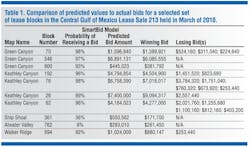Advances in rig design
Nora Haug, Knut B. Engebretsen, Pål Lindstad, Magne Nygård - Aker Solutions
The Aker H-6e design is for the largest and most advanced drilling semisubmersible ever built. The rig was designed for high operability in deepwater and harsh environments such as North Atlantic, Barents Sea, GoM, and Asia/Pacific, with sufficient flexibility for operations in West Africa and other milder areas. The Aker H-6e semi can drill and complete wells in water depths ranging from 70-3,000 m (230-10,000 ft.), with a well depth to 10,000 m (33,000 ft.), with favorable motion characteristics, freeboard, and station-keeping. The rig can adapt to tropical conditions by means of additional chilled water units and increased circulation pump capacity for the air conditioning system. The base version of the rig is winterized, with cladded derrick and heat tracing. It has minimum 7,000 metric tons (7,716 tons) variable payload in transit, up to 10,000 metric tons (11,023 tons) in survival and operating condition. Two Aker H-6e drilling rigs,Aker Spitsbergen and Aker Barents, were scheduled for delivery in June 2009 to the owner Aker Drilling, by the Aker Solutions yard at Stord on the west coast of Norway. Both rigs will then begin long-term contracts on the Norwegian continental shelf.
Drilling system and arrangement
The drilling systems feature a doubleRamRig, which is a latest generation hydraulic lifting cylinder concept with two independent drilling and hoisting systems; the main and the auxiliary well center allow parallel operations. The main rig capacity is 1,000 tons (907 metic tons) and is equipped with four hydraulic cylinders while the auxiliary rig capacity is 500 tons (545 metric tons) and is equipped with two cylinders. The arrangement accommodates low vertical set-back at lower deck level for tubulars and risers, with a fingerboard for tubulars on the drill floor level. The riser type is the Aker Solutions Clip design which speeds the running time because of the unique bolt-less connector type which is very simple to operate. The moon pool area is designed to accommodate an 18 ¾ in., 15,000 psi BOP stack and for independent handling of BOP stack and christmas trees. Both main and auxiliary rig are equipped with under hull and over hull guiding systems for BOP/christmas trees. The dual activity well centers and the independent handling of BOP and christmas trees provide for a range of simultaneous operations with a potential to save time and costs.
Built for harsh environments
The Aker H-6e rig is designed for extreme environmental conditions based on the DNV recommendation for worldwide operations including the North Atlantic. Dimensioning of the rig considers the 100-year wave height, which is important for deck elevation and fatigue requirements. For the thrusters and mooring system, the combined forces from wind, current, and waves set the dimensions. For operability, it is usually a combination of wind, wave, and current forces which size the thrusters in order to keep the rig within the defined offset criteria while drilling.
In areas where hurricanes or typhoons occur, with reliable weather predictions the rig can operate as long as the forecast allows necessary time to disconnect from drilling operations. This is also true when conditions exceed the North Atlantic design criteria. In most cases the rig will be able to evacuate the storm area, but if not, it has sufficient thrust and redundancy to maneuver. In areas with design wind speed exceeding 100 knots, which is the dimensioning wind for stability and allowable VCG and corresponding variable drilling load (VDL), the allowable VCG in survival condition may be reduced to account for a larger wind induced heeling moment.
The regular environmental conditions, up to a one-year condition are more important to efficiency and operability of the rig than are the extreme conditions. In areas with hurricanes and typhoons, the operational conditions usually are significantly better than those in the North Atlantic.
The comparison between 100-year and one-year environmental forces shows that although the extreme condition exceeds the design criteria, which might reduce the payload under survival condition, the capability and operability in operating condition will be as good or better in hurricane and typhoon areas compared to the North Atlantic conditions. For areas with high wind speed but relatively small waves compared with North Atlantic conditions, a reduced survival payload may be compensated by the fact that the rig has enough air-gap to stay on operating draft during extreme events.
Motions
During the hull design and sizing process, the operational motions and air-gap were important factors. Building on the motion characteristics of the Aker H-4.2, the goal for the new geometry was comparable or better motion characteristics. For drilling operations, the combined heave, roll, and pitch motions at well center are the most important limits. Comparing heave motions for different alternative designs shows that one governing parameter is the draft in general – the deeper the operating draft, the better the performance.
Comparing heave motions for operational sea states with wave peak period between eight to 17 seconds, away from any resonance or cancellation periods, the heave is almost independent of number of columns and column shapes for hull geometries with the same displacement, draft, and waterline area, and thus have similar heave natural period.
Selecting the optimal heave natural period is also a factor that affects heave responses for operational sea states. The heave natural period usually is sufficiently high to avoid resonance motions in extreme storms. Recent hull designs seem to have a lower heave natural period than third generation drilling rigs like the Aker H-3. This means that the hull structure has to be designed for larger extreme responses which have a positive effect in operational conditions.
The roll and pitch depend on hull geometry, column size and number, pontoon shape, mass properties, etc. However, the hull design must also consider layout, structural, and tank arrangements, etc.
Air-gap
A parameter governing hull size, stability, and carrying capacity is the elevation of the bottom deck. Depending on the environmental conditions the rig is designed to meet, there is a relationship between operating and survival draft, operating and survival air-gap or distance from the WL (water level) to bottom deck. Most drilling rigs are designed with one or a range of operational drafts and a survival draft for extreme conditions.
For harsh conditions, selecting a survival draft that gives sufficient deck clearance to avoid waves hitting the deck structure in extreme storms is important to avoid damages to the structure and safety equipment. One can design the structure for these wave loads, but the uncertainties in predicting these loads are high and the consequences of downtime repair can be considerable.
The Aker H-6e rig is designed with a relatively large deck elevation, with enough air-gap to avoid damages in a 100-year condition in the North Atlantic, with significant wave height of 17.5 mm (57 ft).
For operability, it is important that air-gap is not the determinant for going to a deeper draft above operational restrictions, but that there is some margin from the limiting operational sea state for drilling operations and for staying connected to the riser, the limiting sea state for air-gap and required survival draft.
In design of the Aker H-6e drilling rigs, air-gap in operational condition is governed by a BF 11-12 condition, which means one can stay on operational draft longer than the criteria for staying connected to the riser. This means that for 99.8% of the year in the North Atlantic, the rig can stay on operation draft.
Station keeping
The Aker H-6e rig is designed as DP-3, with the option for thruster assisted mooring in water depths from 100 m to 500 m (328 ft to 1,640 ft), or alternatively a pre-set system in deeper water. The DP system can keep the MODU on location in all operational conditions.
The rig is designed for a minimum 8-knot transit speed in calm weather (sea trials have shown more than 10 knots). For longer transits, the rig either can use its own power or be supported by tugs. Aker H-6e is capable of having full set back in transit.
Editor’s note: This is an updated version of a paper presented at PennWell’s Deep Offshore Technology (DOT) conference in Perth, Australia, Dec. 3-5, 2008.






